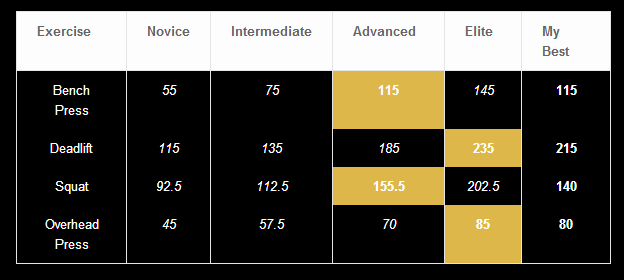The Top 2% of the Weight Training Population?


I had no relevant pictures, so here is my enormous drinking horn.
Good news! Somehow – don’t ask how – I have been confusing my body weight conversations (from stone to kg) for the last year or so. I can now say with certainty that I am 75kg – not 80kg, as I had feared.
Now that probably sounds like nonsense, whiny bullshit. Who cares how much I weigh, right? Wrong. You see, an increase to 80kg puts me in a higher weight category for just about all the sports I do and enjoy.
So, being 75kg is great news for me. Also, as a result, it turns out I’m somewhere around the “top 1% of the weight training population” for my weight category! (According to this website.)
You see, having finally reached 12 stone, I thought I was reaching 80kg and therefore risking being a) weaker compared to my bodyweight and b) in higher weight categories in a range of sports. However, it turns out that I misjudged my calculation and am still:
- Smack back in the middle of my wrestling weight class (70 – 79kg)
- The heaviest end of middleweight in boxing
- A welterweight in the eyes of British Association of Mixed Martial Arts
- Bang on the 75kg power-lifting weight class
Regarding that final one (power-lifting), I have discovered the weights that athletes at various degrees of training can reasonably be expected to lift a single time (using a full range-of-motion and no supportive wraps or suits).
This websitebreaks the info down into weight class (all of which I have ignored, expect my own 75kg). It also breaks down the training development into these categories:
- Untrained: the expected level of strength in a healthy individual who has not trained in the exercise before.
- Novice: a person training regularly for a period of 3-9 months. This strength level supports the demands of vigorous recreational activities.
- Intermediate: a person who has engaged in regular training for up to two years. The intermediate level indicates some degree of specialization in the exercises and a high level of performance at the recreational level.
- Advanced: an individual with multi-year training experience with definite goals in the higher levels of competitive athletics.
- Elite: refers specifically to athletes competing in strength sports. Less than 2% of the weight training population will attain this level. Please note, this used to read “top 1%”, but has subsequently been changed – apologies for any confusion.
For the purposes of my comparison, I removed the ‘Untrained’ standard, as it seemed redundant. Below are my findings, for the four lifts I work around:
| Exercise | Novice | Intermediate | Advanced | Elite | My Best |
|---|---|---|---|---|---|
| Bench Press | 55 | 75 | 115 | 145 | 115 |
| Deadlift | 115 | 135 | 185 | 235 | 215 |
| Squat | 92.5 | 112.5 | 155.5 | 202.5 | 140 |
| Overhead Press | 45 | 57.5 | 70 | 85 | 80 |
To summarise:
- My bench press is smack on advanced, at 115kg.
- My deadlift is marginally closer to elite than advanced, at 215kg.
- My squat is my weakest, at is 15.5kg off advanced, but 27.5kg above intermediate at 140kg [EDIT: as of 2013, this has increased to 160kg, which is slightly above advanced].
- My overhead press, somehow, is also closer to elite than advanced…though I haven’t achieved an overhead press of 80kg for some time – it’s likely closer to 70-75kg at the moment.
My new goal, of course, is to be elite at everything. This will, however, take forever to achieve. Still, it is worth having a goal!
Feb 20, 2012 at 5:23 PM /
[…] I’m getting there. Slowly, but surely. Read more by clicking on the title of this post. Via edvssport.wordpress.com Share this:FacebookTwitterLike this:LikeBe the first to like this […]